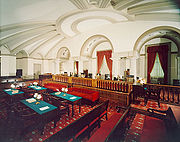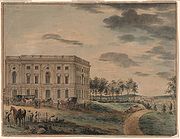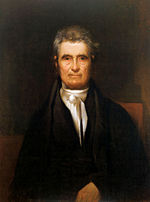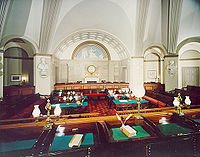
Old Supreme Court Chamber
Encyclopedia

United States Capitol
The United States Capitol is the meeting place of the United States Congress, the legislature of the federal government of the United States. Located in Washington, D.C., it sits atop Capitol Hill at the eastern end of the National Mall...
. From 1800 to 1806, the room was the lower half of the first United States Senate
United States Senate
The United States Senate is the upper house of the bicameral legislature of the United States, and together with the United States House of Representatives comprises the United States Congress. The composition and powers of the Senate are established in Article One of the U.S. Constitution. Each...
chamber, and from 1810 to 1860, the courtroom for the Supreme Court of the United States
Supreme Court of the United States
The Supreme Court of the United States is the highest court in the United States. It has ultimate appellate jurisdiction over all state and federal courts, and original jurisdiction over a small range of cases...
.
History and use
Construction on the North Wing began in 1793 with the laying of the cornerstone by President George WashingtonGeorge Washington
George Washington was the dominant military and political leader of the new United States of America from 1775 to 1799. He led the American victory over Great Britain in the American Revolutionary War as commander-in-chief of the Continental Army from 1775 to 1783, and presided over the writing of...
. Although interior work was unfinished, the Senate relocated from Philadelphia in November 1800. The interior of the chamber, including an upper level public gallery, was finally completed early in 1805, just in time for the start of the Samuel Chase impeachment trial. Its completion allowed the Federal government to move to Washington, D.C.
Washington, D.C.
Washington, D.C., formally the District of Columbia and commonly referred to as Washington, "the District", or simply D.C., is the capital of the United States. On July 16, 1790, the United States Congress approved the creation of a permanent national capital as permitted by the U.S. Constitution....
. The North Wing, as the only completed section of the Capitol, originally hosted both houses of the United States Congress
United States Congress
The United States Congress is the bicameral legislature of the federal government of the United States, consisting of the Senate and the House of Representatives. The Congress meets in the United States Capitol in Washington, D.C....
, the Library of Congress
Library of Congress
The Library of Congress is the research library of the United States Congress, de facto national library of the United States, and the oldest federal cultural institution in the United States. Located in three buildings in Washington, D.C., it is the largest library in the world by shelf space and...
, and the Supreme Court
Supreme Court of the United States
The Supreme Court of the United States is the highest court in the United States. It has ultimate appellate jurisdiction over all state and federal courts, and original jurisdiction over a small range of cases...
.

Thomas Jefferson
Thomas Jefferson was the principal author of the United States Declaration of Independence and the Statute of Virginia for Religious Freedom , the third President of the United States and founder of the University of Virginia...
inauguration in 1801. However, by 1806, the North Wing was already deteriorating from heavy use and required repairs. The Architect of the Capitol
Architect of the Capitol
The Architect of the Capitol is the federal agency responsible for the maintenance, operation, development, and preservation of the United States Capitol Complex, and also the head of that agency. The Architect of the Capitol is in the legislative branch and is responsible to the United States...
at the time, Benjamin Henry Latrobe, decided that the repairs would provide opportunity to expand room space in the Capitol by dividing the chamber in half. The upper half would serve as a new chamber for the Senate (that area is now known as the Old Senate Chamber
Old Senate Chamber
The Old Senate Chamber is a room in the United States Capitol that was the legislative chamber of the United States Senate from 1810 to 1859. It was designed in Neoclassical style and is elaborately decorated...
), and the lower half would be used for the Supreme Court.
In 1844, Samuel Morse sent the first Morse coded message, which read, "What hath God wrought
What hath God wrought
"What hath God wrought" is a phrase from the Book of Numbers and may refer to:*"What hath God wrought", a message in American Morse code sent by Samuel F. B...
?", from this room.
Design and construction
The size and structure of Latrobe's vaulted, semicircular ceiling were virtually unprecedented in the United States. The room is 50 feet deep and 74 feet, eight inches wide. Construction began in November 1806 with the gutting of the former two story Senate Chamber and rooms above it, and lasted until 1810. The process was not without tragedy, when an assistant to Latrobe, John LenthallJohn Lenthall
John Lenthall may refer to:People* Sir John Lenthall, 1st Baronet, , English lawyer and member of parliament* John Lenthall , , Shipbuilder of Philadelphia Ships...
, Clerk of the Works, was killed upon removing a center wooden ceiling support prematurely against Latrobe's advice. The result was that the unfinished masonry ceiling collapsed crushing Lenthall in the process. Lenthall's death was a setback, not only to construction, but to Latrobe's reputation as an architect, which he struggled to rebuild for the rest of his career.
Fire of 1812 and reconstruction

United Kingdom
The United Kingdom of Great Britain and Northern IrelandIn the United Kingdom and Dependencies, other languages have been officially recognised as legitimate autochthonous languages under the European Charter for Regional or Minority Languages...
invasion during the War of 1812
War of 1812
The War of 1812 was a military conflict fought between the forces of the United States of America and those of the British Empire. The Americans declared war in 1812 for several reasons, including trade restrictions because of Britain's ongoing war with France, impressment of American merchant...
. On August 24, 1814, the British successfully took the city, and set fire to many of the recently completed buildings of the fledgling capital, including the North and South wings of the Capitol building. Despite the disaster which left much of the North Wing gutted, the chamber with its vaulted ceiling survived. With safety in mind, however, Latrobe ordered the ceiling broken down and rebuilt for the final time in 1815. Latrobe resigned two years later, and it was under his successor, Charles Bulfinch
Charles Bulfinch
Charles Bulfinch was an early American architect, and has been regarded by many as the first native-born American to practice architecture as a profession....
, that the chamber was completed in 1819, in time for the next session of the Supreme Court.
The Supreme Court resided in the chamber for the next forty-one years, until 1860. In that time period, the court heard arguments on such landmark cases as McCulloch v. Maryland
McCulloch v. Maryland
McCulloch v. Maryland, , was a landmark decision by the Supreme Court of the United States. The state of Maryland had attempted to impede operation of a branch of the Second Bank of the United States by imposing a tax on all notes of banks not chartered in Maryland...
, Gibbons v. Ogden
Gibbons v. Ogden
Gibbons v. Ogden, 22 U.S. 1 , was a landmark decision in which the Supreme Court of the United States held that the power to regulate interstate commerce was granted to Congress by the Commerce Clause of the United States Constitution. The case was argued by some of America's most admired and...
, Dred Scott v. Sandford
Dred Scott v. Sandford
Dred Scott v. Sandford, , also known as the Dred Scott Decision, was a ruling by the U.S. Supreme Court that people of African descent brought into the United States and held as slaves were not protected by the Constitution and could never be U.S...
, and the The Amistad
Amistad (1841)
The Amistad, also known as United States v. Libellants and Claimants of the Schooner Amistad, 40 U.S. 518 , was a United States Supreme Court case resulting from the rebellion of slaves on board the Spanish schooner Amistad in 1839...
. Two Chief Justices—John Marshall
John Marshall
John Marshall was the Chief Justice of the United States whose court opinions helped lay the basis for American constitutional law and made the Supreme Court of the United States a coequal branch of government along with the legislative and executive branches...
and Roger Taney—presided over the Supreme Court in the chamber.
Post-Supreme Court and restoration
Upon the departure of the Supreme Court to the Old Senate ChamberOld Senate Chamber
The Old Senate Chamber is a room in the United States Capitol that was the legislative chamber of the United States Senate from 1810 to 1859. It was designed in Neoclassical style and is elaborately decorated...
upstairs in 1860, the chamber was put to use as a law library
Law library
A law library is a library designed to assist law students, attorneys, judges, and their law clerks and anyone else who finds it necessary to correctly determine the state of the law....
. After the Supreme Court finally vacated the Capitol building itself for their present-day quarters in the Supreme Court building
United States Supreme Court building
The Supreme Court Building is the seat of the Supreme Court of the United States. It is situated in Washington, D.C. at 1 First Street, NE, on the block immediately east of the United States Capitol. The building is under the jurisdiction of the Architect of the Capitol. On May 4, 1987, the Supreme...
, the room was used as a reference library, and later as a committee room for the Joint Committee on Atomic Energy
United States Congress Joint Committee on Atomic Energy
The Joint Committee on Atomic Energy was a United States congressional committee that was tasked with exclusive jurisdiction over "all bills, resolutions, and other matters" related to civilian and military aspects of nuclear power from 1946 through 1977...
from 1955 to 1960. From 1960 to 1972, the chamber was given the rather mundane purpose of being a storage room, until Congress voted to restore the chamber to its antebellum appearance.
An 1854 diagram of the chamber was used to establish the layout and positioning of furniture in the chamber, and a portrait of John Marshall provided clues towards a mahogany
Mahogany
The name mahogany is used when referring to numerous varieties of dark-colored hardwood. It is a native American word originally used for the wood of the species Swietenia mahagoni, known as West Indian or Cuban mahogany....
railing
Guard rail
Guard rail or guardrail, sometimes referred to as guide rail or railing, is a system designed to keep people or vehicles from straying into dangerous or off-limits areas...
and the carpet
Carpet
A carpet is a textile floor covering consisting of an upper layer of "pile" attached to a backing. The pile is generally either made from wool or a manmade fibre such as polypropylene,nylon or polyester and usually consists of twisted tufts which are often heat-treated to maintain their...
pattern. Still existing furnishings in the possession of the United States Capitol were sent to the chamber, as well as donated items such as Roger Taney's chair. By 1975, the chamber was opened to the public and has served as a museum ever since.
Artwork in the Old Supreme Court Chamber

John Jay
John Jay was an American politician, statesman, revolutionary, diplomat, a Founding Father of the United States, and the first Chief Justice of the United States ....
, John Rutledge
John Rutledge
John Rutledge was an American statesman and judge. He was the first Governor of South Carolina following the signing of the Declaration of Independence, the 31st overall...
, Oliver Ellsworth
Oliver Ellsworth
Oliver Ellsworth was an American lawyer and politician, a revolutionary against British rule, a drafter of the United States Constitution, and the third Chief Justice of the United States. While at the Federal Convention, Ellsworth moved to strike the word National from the motion made by Edmund...
, and John Marshall
John Marshall
John Marshall was the Chief Justice of the United States whose court opinions helped lay the basis for American constitutional law and made the Supreme Court of the United States a coequal branch of government along with the legislative and executive branches...
. A bust of Roger Taney, as well his original robe on display, is found in the adjacent Robing Room, which serves as the entrance for visitors into the chamber. Above one fireplace is a clock ordered by Roger Taney, and set five minutes forward under his direction to promote promptness on the court proceedings. Above the clock is a plaster relief of Lady Justice
Lady Justice
Lady Justice |Dike]]) is an allegorical personification of the moral force in judicial systems.-Depiction:The personification of justice balancing the scales of truth and fairness dates back to the Goddess Maat, and later Isis, of ancient Egypt. The Hellenic deities Themis and Dike were later...
, notable for a lack of blindfold
Blindfold
A blindfold is a garment, usually of cloth, tied to one's head to cover the eyes to disable the wearer's sight. It can be worn when the eyes are in a closed state and thus prevents the wearer from opening them...
. She is accompanied by America, depicted as a winged youth, holding the United States Constitution as a star overhead shines light upon the document. Although never specified by the artist, Justice looks to the document with her unblinded eyes. An eagle seen protecting law books and an owl beneath Justice two symbolic birds are featured in the sculpture. The relief was the work of Carlo Franzoni in 1817.

